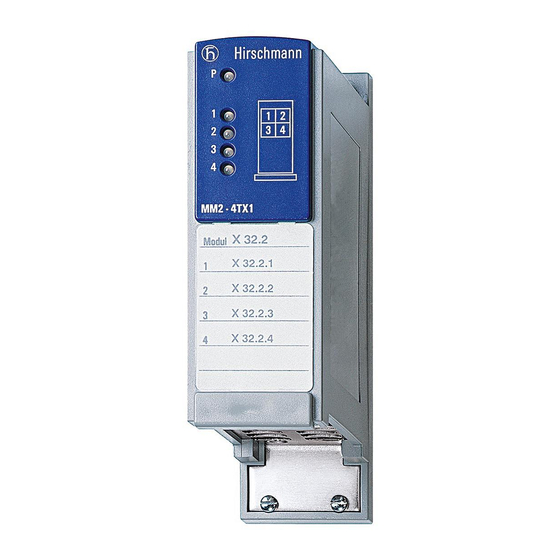Summarization of Contents
Safety and Compliance
Important Information and Hazard Levels
Provides critical notices, equipment familiarization, and definitions for DANGER, WARNING, CAUTION levels.
Certified Usage and Supply Voltage
Details authorized use, approved components, electrical supply requirements, and isolation.
National and International Regulations
Covers safety regulations, CE marking, FCC compliance, and recycling notes for safe operation.
About this Manual
Manual Content and Related Documents
Explains the purpose of the Installation manual and lists other available manuals on CD-ROM.
Legend
Symbol Definitions
Defines symbols used in the manual, such as for listings, work steps, and subheadings.
Device Description
Overview of PowerMICE Devices
Introduces PowerMICE devices as industrial Ethernet switches, highlighting reliability and features.
1.1 Description of the Modules
Explains the system composition of basic, media, and expansion modules for PowerMICE industrial Ethernet switches.
1.1.1 PowerMICE Basic Module MS4128
Describes the MS4128 basic module, its function units, slots, and connectivity options for media modules.
1.1.2 Media Modules Overview
Details various media modules (MM2, MM3, MM4, MM22) and their interface-specific functions for LAN connectivity.
1.1.3 MB-2T Expansion Module
Explains the MB-2T expansion module's role in adding two additional slots for media modules to the basic module.
1.1.4 SFP Modules
Describes SFP (Small Form-factor Pluggable) modules used as optical transceivers for F/O ports.
Assembly and Start-up
2.1 Overview of Installation
Provides a general overview of the installation process for PowerMICE switches, emphasizing unique IP addresses.
2.2 Installing the Device
Covers unpacking, checking, installing media and SFP modules, and attaching labels.
2.2.1 Unpacking and Checking
Instructions for verifying package contents and checking for transport damage before proceeding with installation.
2.2.2 Installing Media Modules
Details the procedure for installing and removing media modules during operation, including securing them.
2.2.3 Filling Out and Attaching Labels
Explains how to use provided labels to clearly designate and assign modules and connected devices.
2.2.4 Installing SFP Modules
Guides on inserting SFP modules into slots until they audibly latch, using Hirschmann-approved modules.
2.2.5 Adjusting DIP Switch Settings on Basic Module
Details the 6-pin DIP switch functions on the basic module for configuration like Redundancy Manager and HIPER-Ring.
2.2.6 Adjusting DIP Switch Settings on MM20-A8A89999SAHH
Explains the 3-pin DIP switch settings on the MM20-A8A89999SAHH media module for SQE test and DTE voltage.
2.2.7 Connecting PoE Media Module
Provides instructions for connecting the MM22-T1T1T1T1 PoE media module with its power supply unit requirements.
2.2.8 Connecting Terminal Blocks
Details connecting supply voltage and signal contacts using 4-pin terminal blocks and securing them.
2.2.9 Terminal Blocks Installation & Start-up
Explains mounting terminal blocks and initiating device operation by connecting the voltage supply.
2.2.10 DIN Rail Mounting & Grounding
Describes how to mount the device on a 35 mm DIN rail and the grounding methods used.
2.2.11 Connecting Data Lines
Guides on connecting data lines to media module ports for setting up industrial Ethernet networks.
2.2.12 Installing Expansion Module
Explains the procedure for installing the MB-2T expansion module to add more slots, even while the device is operating.
2.2.13 Defining Display LED Meaning
Explains how to use the 'SELECT' button on the basic module to define the meaning of media module port LEDs.
2.3 Display Elements
Describes the device status LEDs and their meanings, indicating conditions affecting the whole device operation.
2.4 Basic Set-up
Covers initial IP parameter configuration options, default settings, and management access for the device.
2.5 Maintenance
Provides guidance on device maintenance, checks for wear, software updates, and keeping ventilation slots clear.
2.6 Disassembly
Details the steps for safely removing the device from the DIN rail and disassembling SFP modules.
Technical Data
General Technical Data
Lists key specifications including dimensions, weight, operating voltage, signal contact, environment, and protection classes.
Dimension Drawing
Provides a technical drawing illustrating the physical dimensions and mounting details of the device.
EMC and Immunity
Details EMC compliance, immunity tests, emitted interference standards, and stability criteria such as vibration and shock.
Network Range and Transceiver Data
Specifies line lengths for transceivers, including fiber attenuation, dispersion, and product codes.
TP and AU Port Specifications
Details maximum segment lengths for Twisted Pair (TP) and AUI ports.
Module Power, Temperature, and Order Numbers
Lists power consumption, output, operating temperatures, and order numbers for basic, MM2, MM3, MM4, and other modules.
Media Module Variants and Certifications
Explains product codes for media module variants and lists relevant certifications like CE, UL, and ATEX.
Interfaces and Scope of Delivery
Describes the V.24 and USB interfaces, and lists the items included in the device's scope of delivery.
Norms and Standards
Underlying Norms and Standards
Lists and describes the various norms and standards that the device adheres to for compliance.
Further Support
Technical Questions and Contact Information
Provides contact details for technical questions, support email addresses, and phone numbers by region.
Hirschmann Competence Center Services
Details services offered by the Competence Center, including technical consulting, product training, and support.

















Need help?
Do you have a question about the PowerMICE MM3-2FXM2/2TX1 and is the answer not in the manual?
Questions and answers